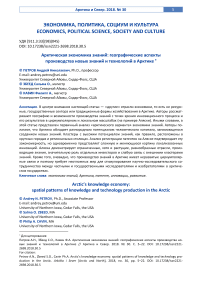Арктическая экономика знаний: географические аспекты производства новых знаний и технологий в Арктике
Автор: Петров Андрей Николаевич, Збеед Сальма О., Кавин Филипп А.
Журнал: Арктика и Север @arcticandnorth
Рубрика: Экономика, политика, социум и культура
Статья в выпуске: 30, 2018 года.
Бесплатный доступ
В центре внимания настоящей статьи - «другие» отрасли экономики, то есть не ресурсные, государственные сектора или традиционные формы хозяйствования в Арктике. Авторы рассматривают географию и возможности производства знаний с точки зрения инновационного процесса и его результатов в циркумполярном и локальном масштабах (на примере Аляски). Иными словами, в этой статье представлен первичный анализ «арктического варианта» экономики знаний. Авторы полагают, что Арктика обладает разнородным потенциалом человеческого капитала, занимающегося созданием новых знаний. Кластеры с высоким потенциалом знаний, как правило, расположены в крупных городах и региональных столицах. Анализ регистрации патентов на Аляске подтверждает эту закономерность, но одновременно представляет сложную и меняющуюся картину локализованных инноваций. Аляска демонстрирует ограниченные, хотя и растущие, разнообразные отрасли, производящие знания, значительную роль отдельных инвесторов и слабую связь с внешними кластерами знаний. Кроме того, очевидно, что производство знаний в Арктике имеет неразвитые циркумполярные связи и поэтому требует неотложных мер для стимулирования научно-исследовательского сотрудничества между частными и государственными исследователями и изобретателями в арктических государствах.
Экономика знаний, арктика, патент, инновации, развитие
Короткий адрес: https://sciup.org/14823252
IDR: 14823252 | DOI: 10.17238/issn2221-2698.2018.30.5
Список литературы Арктическая экономика знаний: географические аспекты производства новых знаний и технологий в Арктике
- Knapp G., Huskey L. Effects of Transfers on Remote Regional Economies: the Transfer Economy in Rural Alaska//Growth and Change. 1988. Vol. 19. № 2. P. 25-39.
- Glomsrød S., Duhaime G., Aslaksen I., eds. The economy of the North 2015//Statistical analyses 151: Statistisk sentralbyrå. 2017. 168 p.
- Petrov A. Exploring the Arctic’s "other economies": knowledge, creativity and the new frontier//The Polar Journal. 2016. Vol. 6. № 1. P. 51-68.
- Huskey L. Globalization and the economies of the North//Globalization and the circumpolar north. Ed.: L. Heininen, C. Southcott. Fairbanks: University of Alaska Press. 2010.
- Glomsrød S., Aslaksen I., eds. The economy of the North 2008//Statistical analyses: Statistisk sentralbyra. 2008. 102 p.
- Rasmussen R.O., ed. Megatrends. Copenhagen: Nordic Council of Ministers. 2011. 205 p.
- Beyers W.B., Lindahl D.P. Lone Eagles and High Fliers in Rural Producer Services//Rural Development Perspectives. 2001. Vol. 11. № 3. P. 2-10.
- Boschma R.A. Social Capital and Regional Development: an Empirical Analysis of the Third Italy//Learning from Clusters: a Critical Assessment from an Economic-Geographical Perspective. Ed.: R.A. Boschma, R.C. Kloosterman. Netherlands: Springer. 2005. P. 139-168.
- Gradus Y., Lithwick H. Frontiers in Regional Development. Lanham, MD: Rowman & Littefield. 1996. 288 p.
- Selada C., Cunha I.V., Tomaz E. Creative-based strategies in small cities: a case-study approach//Redige. 2011. Vol. 2. № 2. P. 79-111.
- Petrov A. Creative Arctic: Towards Measuring Arctic’s Creative Capital//Arctic Yearbook 2014. Ed.: L. Heininen. Akureyri, Iceland. 2014. P. 149-166
- Hirshberg D., Petrov A. Education and Human Capital//Arctic Human Development Report: Regional Processes and Global Linkages. Ed.: J. Larsen, G. Fondahl. Copenhagen: Nordic Council of Ministers. 2015. P. 349-399.
- Florida R. The Economic Geography of Talent//Annals of the Association of American Geographers. 2002. Vol. 92. № 4. p. 743-755.
- Aarsæther N. (ed.) Innovations in the Nordic Periphery//Nordregio Report 2004:3. Stockholm. 2004. 264 p.
- Пилясов А. И последние станут первыми. Северная периферия на пути к экономике знания. Москва: Либроком. 2009. 544 с.
- Petrov A. Beyond spillovers: Interrogating innovation and creativity in the peripheries//Beyond territory: dynamic geographies of innovation and knowledge creation. Ed.: H. Bathelt, M. Feldman, D.F. Kogler. London: Routledge. 2011. P. 168-190.
- The high-tech industry, what is it and why it matters to our economic future?//Beyond the Numbers. BLS. 2016. Vol. 5. № 8. P. 1-7.
- Acs Z.J., Audretsch D.B. Patents as a measure of innovative activity//Kyklos. 1989. Vol. 42. № 2. P. 171-180.
- Feldman M.P. Location and innovation: the new economic geography of innovation, spillovers, and agglomeration//The Oxford handbook of economic geography. Ed.: G.L. Clark, M.S. Gertler, M.P. Feldman. USA: Oxford University Press. 2000. P. 373-394.
- Archibugi D. Patenting as an indicator of technological innovation: a review//Science and Public Policy. 1992. Vol. 19. № 6. P. 357-368.
- Kogler D.F. Intellectual Property and Patents: Knowledge Creation and Diffusion//The Handbook of Manufacturing Industries in the World Economy. Ed.: J. Clark, V. Vanchan, J.B. Bryson. Cheltenham, UK: Edward Elgar. 2014. P. 1-25.
- Voswinkel S. Survey of Yukon's Knowledge Sector: Results and Recommendations. Yukon Research Centre. Yukon College. Whitehorse, YT. 2012.
- Zbeed S., Petrov A. Inventing the New North: Patents & Knowledge Economy in Alaska//Arctic Yearbook 2017. Akureyri, Iceland. 2017.
- Berkman P.A., Kullerud L., Pope A., Vylegzhanin A.N., Young O.R. The Arctic Science Agreement propels Science diplomacy//Science. 2017. Vol. 358. № 6363. P. 596-598.


